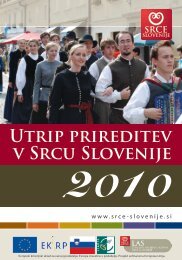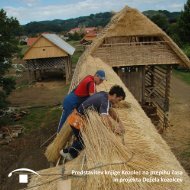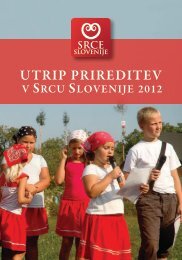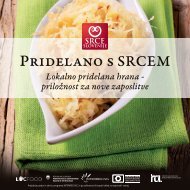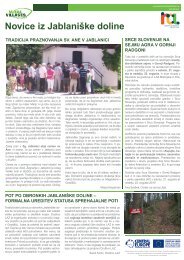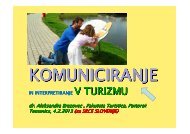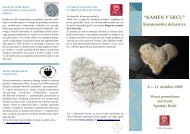Naše kulturno bogastvo - Razvojni center Srca Slovenije
Naše kulturno bogastvo - Razvojni center Srca Slovenije
Naše kulturno bogastvo - Razvojni center Srca Slovenije
- No tags were found...
Create successful ePaper yourself
Turn your PDF publications into a flip-book with our unique Google optimized e-Paper software.
CarpentryCarpentry is considered to be oneof the oldest crafts. It first appearedmore than five thousand years ago.Owing to the necessity of buildingsafe housing structures, alreadyin the early metal periods peoplemet with various methods of woodprocessing: thus various residentialfacilities and estate buildings,wooden footbridges, bridges andother useful structures emerged.Carpentry as an important craftsmanactivity left a strong markin particular in the Mirna Rivervalley. The valley is known for theconstruction of its hayracks. It isin the very Valley that magnificentcarpentry masterpieces with themost picturesquely ornamentedhayracks have sprung up.Carpentry requires a lot of knowledgeand experience: consequently, mastercarpenters have always been mostlyexperienced elderly men. The activity isvery much alive everywhere today becauseas a rule most roof trusses are stillmade of wood. In the Mirna River valley,wooden buildings, i.e. walls, were manufacturedin the past. The constructionof wooden double hayracks boomedparticularly in the 19th and in the firsthalf of the 20th centuries. The firstsimple hayracks appeared in the MirnaRiver valley as early as in the middle ofthe 17th century, which is documentedin the pictorial documents of that time.The development of new farming technologiesrequired carpenters to find newcarpentry-related solutions: this is whythe first double hayracks appeared inthe Mirna River valley. Double hayrackswere in their prime in the 1930s. At thattime carpenters from Lower Carniolabuilt the most remarkable and construction-wisethe most demanding doublehayracks – toplarji. As many as sevencarpenters were active then and theydiffered from each other as to the executionof details on the hayracks. The mosteminent master carpenters were JanezKarlič Jr. from Veliki Cirnik, Jože Kafolfrom Trebelno and Janko Gregorčič fromSlovenska vas near Šentrupert. The lattermade the Simončič double hayrack inBistrica near Šentrupert: this is the onlyhayrack in Slovenia that boasts thestatus of a national cultural monument.Two basic conditions for good carpentryare good tools to hew with and wellpreparedwood. The carpentry seasonlasted from spring to autumn. In winterwood was felled, it was predominantlyspruce wood, while oak was used forthe main parts of a hayrack (i.e. supportingpoles). The wood was then leftto dry until spring when they startedhewing it. This was followed by bindingtogether individual assemblies of theconstruction on the ground to checkthe adequacy of the processing andbinding of the wood. These structureswere then completely disassembled andassembled into a whole, i.e. a hayrack.If someone wanted to become a mastercarpenter he had to go through anapprenticeship that comprised practicallearning by teaching masters. Theapprenticeship was a time when apprenticeslearnt to process wood andthe laws applying to the construction ofwooden facilities. Later on experiencedmasters, too, were thinking while workingand introduced new solutions forwhich they had to get the approval oftheir client. Alojzij Gregorčič, who gotmost of his knowledge from his fatherJanko Gregorič, from Slovenska vas nearŠentrupert, conveys his knowledge andknowingness about carpentry craftsmanshipto others in the area of theMirna River valley.Carpentry provides the Mirna Rivervalley with a strong feature – throughits hayracks it shapes the image of theman-made environment and the characteristicalpicturesqueness of the rurallandscape. The project Open-Air Museum– hayracks in Šentrupert returnscarpentry to the stand and position itdeserves, once again carpentry is gainingimportance, with its basic premisesand the laws being the foundation tobuild a museum. In addition, owing tothe pleasantness of living here and tothe friendly environment, traditionalbuilding techniques and the use ofwood have been on the increase.61




